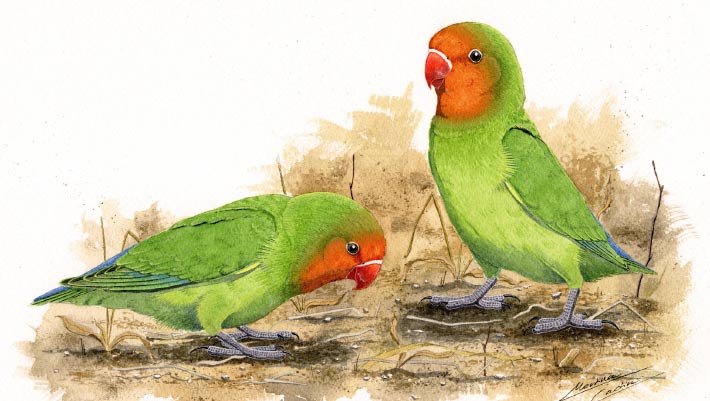Paleontologists have found the fossilized bones from a new species of the parrot genus Agapornis at three localities of the UNESCO World Heritage site of the Cradle of Humankind in Gauteng Province, South Africa.
Life reconstruction of a pair of Agapornis longipes feeding on the ground in the Early Pleistocene of the Cradle of Humankind, Gauteng, South Africa, during the dry season. Image credit: Martina Cadin.
“Lovebirds (genus Agapornis) are small-sized parrots endemic to sub-Saharan Africa and Madagascar,” said Dr. Marco Pavia from the Università degli Studi di Torino and his colleagues.
“They currently include nine species living in woodlands or wooden savannahs where they breed in tree cavities and feed on grass seeds or fruits collected primarily on the ground and, to a lesser degree, on trees.”
“According to genetic data, parrots colonized Africa in the Late Eocene/Early Oligocene and Agapornis only colonized Africa from Australasia in the Late Oligocene/Early Miocene, around 24 million years ago.”
“Psittacula krameri is the latest parrot to have dispersed into the continent, near the Plio-Pleistocene boundary (2.5-1.5 million years ago).”
“The fossil record of parrots in Africa is very scarce and the oldest dates back to the Early Pliocene of Langebaanweg.”
“Remarkably, most of the African fossils were attributed to Agapornis, the oldest of which is represented by Agapornis attenboroughi described from the Early Pliocene of Langebaanweg, South Africa.”
The newly-identified species, Agapornis longipes, lived in South Africa approximately 2.5 million years ago.
Its fossilized remains were found at Kromdraai, Cooper’s Cave and Swartkrans sites in South Africa.
The specimens include all major wing bones (humerus, ulna, and carpometacarpus), the tarsometatarsus, a fragmentary mandible and coracoid.
“The fossils were retrieved from three localities in the UNESCO World Heritage site of the Cradle of Humankind, a key area for understanding early hominin evolution in southern Africa,” the paleontologists said.
“The Cradle of Humankind contains several hominin-bearing localities that span from the Late Pliocene to the Late Pleistocene and their studies illuminate the paleoecological and paleoenvironmental contexts surrounding the appearance of the genus Homo in the region, as well as its relationship with contemporaneous australopithecines and Paranthropus.”
“The three fossil sites of Swartkrans, Cooper’s Cave and Kromdraai are a few hundred meters from each other, located in the southern part of the Cradle, respectively 1 km east and ca. 1.5 km northeast of the Sterkfontein Caves,” they added.
Agapornis longipes is distinguished from the nine living species of the Agapornis genus and from the extinct Agapornis atlanticus and Agapornis attenbouroughi by several morphological characters and by the smallest humerus/tarsometatarsus ratio of all Agapornis species.
“All but one Agapornis species are grass seed eaters and secondarily fruit eaters, and are generally related to the presence of grassland, permanent water resources and tall trees that provide either natural cavities or holes excavated by other birds such as woodpeckers or barbets,” the researchers said.
“The elongated feet of Agapornis longipes could relate to the feeding adaptation of this extinct species.”
“In fact, the modern species with the lower humerus/tarsometatarsus ratios typically collect food on the ground, while the others also collect seeds or fruits from the trees.”
“We thus hypothesize that Agapornis longipes took advantage of its longer legs to feed on grass seeds on the ground in the tall and dense grassland of the paleo-Bloubank valley as suggested by the paleoenvironmental reconstructions.”
“The present-day environment of the Cradle of Humankind and of this part of South Africa is not markedly different from that of the Early Pleistocene, and the extinction of the lovebirds from this region during the Pleistocene was most probably related to a change in microclimatic conditions or to the extinction of specific food resources rather than to the change of general environmental conditions.”
The new species is described in a paper in the journal Geobios.
_____
Marco Pavia et al. A new species of Lovebird (Aves, Psittaculidae, Agapornis) from the Plio-Pleistocene of the Cradle of Humankind (Gauteng, South Africa). Geobios, published online August 9, 2024; doi: 10.1016/j.geobios.2024.05.006

